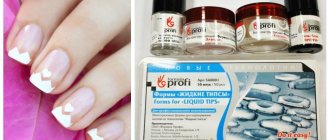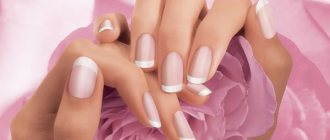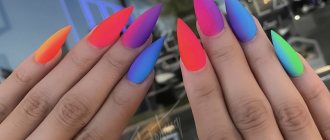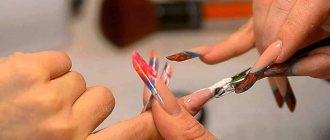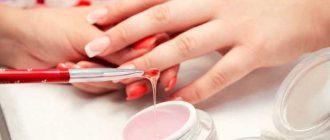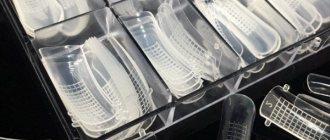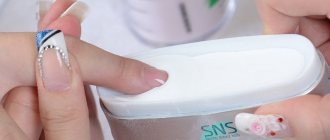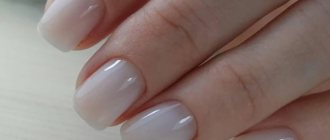- July 29, 2018
- Nail care
- Lazareva Valeria
A neat manicure gives a girl, or rather her hands, a well-groomed look. However, not every lady has perfect nails. They can flake, break, be uneven, etc. That is why acrylic for manicure is used to give the nails the desired shape. This material is often used for building or strengthening. Having familiarized yourself with the technique of use in detail, you can perform the procedure yourself.
What is acrylic used for?
The effect is noticeable immediately after covering the nails with the material. They become denser and stronger. Thanks to its unique properties, acrylic applied to nails protects them from mechanical stress, ultraviolet radiation, exposure to cold and aggressive household chemicals, as well as from dirt and dust. That is why the plate is strengthened under acrylic, and delamination occurs less often.
You need to understand that this is a synthetic material. Therefore, strengthening of nails does not occur due to the penetration of nutrients. The whole effect is achieved thanks to a kind of acrylic shell. If everything is done correctly, the material does not flow onto the cuticle or side ridges, and detachments do not appear.
Minuses
There are surprisingly few of them. Like any synthetic material, acrylic can cause allergies. However, according to statistics, this occurs in no more than 5% of clients. However, this does not mean that you can neglect safety rules. Before you are interested in how to use acrylic for nails, you need to make sure that you are not allergic.
In addition, the material has a rather pungent and unpleasant odor, which may be unbearable for some. Not all girls are ready to endure discomfort. Even to get the nails of your dreams. You need to work with acrylic in rooms with good ventilation.
Pros and cons of acrylic nails
- Hypoallergenic. Only 5-7% of people had any allergic reactions while using acrylic powder. Thus, this cosmetic product is suitable for almost everyone. Also, acrylic sawdust is much larger and heavier than gel sawdust, due to which acrylic dust scatters less and is not so dangerous for asthmatics and allergy sufferers;
- Variety of structures and colors;
- Persistence. For this property, powder is especially valued by professional manicurists. The effect after application lasts up to two weeks, the paint layer does not chip or break, and the nail plate is not deformed. Acrylic nails can be worn for up to 3-4 months, provided that regular corrections are carried out;
- Strength. Thanks to this property of the product, you can create various artistic compositions on your nails. This material is suitable for those who work a lot with their hands. Acrylic can also be used to “repair” natural nails. It is important to remember, however, that acrylic only fully hardens 48 hours after application;
- Naturalness. Acrylic looks as natural as possible on nails if you choose natural shades of powder for extensions;
- Quick to apply. If you fill your hand or have your nails extended with acrylic in a professional salon, then thanks to the quick-drying effect of the powder (30 seconds), the procedure will not take much time (1.5 - 2 hours);
- Easy to remove. Acrylic nails are easy to remove. This requires only a special solution.
Of the disadvantages of this nail extension product, it is worth noting three main ones:
- Unpleasant smell. The smell occurs when liquid, monomer, is added to the powder. Therefore, it is necessary to do acrylic nail extensions only in well-ventilated areas, preferably wearing a special respirator mask. True, recently the composition of the monomers has been changed (MMA, methyl methacrylate has been replaced by EMA, ethyl methacrylate), since a substance hazardous to health was discovered in the past, and the smell seems to have ceased to be so pungent;
- Dull appearance. Acrylic nails require polishing or a topcoat to look brighter, as acrylic initially has a matte finish. Low-quality acrylic can generally give the nails a painful yellowish tint, so in this case you cannot do without varnish;
- Quick-drying composition. And this can really become a problem if you lack experience working with acrylic. So if you plan to use it at home, you should first practice to get used to it.
Types of acrylic
To understand how to use acrylic nails, you need to know what types of material are on the market.
- Transparent powder is considered universal. It is used for both building and strengthening. This is also a great option for creating a classic French manicure. Nail artists use transparent powder for decoration, creating beautiful designs and sculpting. To achieve the desired result, transparent acrylic powder is mixed with glitter, dyes and other decorative elements.
- Camouflage powder is useful to disguise defects or hide unevenness. Typically, this acrylic has a beige tint, reminiscent of skin color. This allows you to imitate a natural nail. Camouflage acrylic has a denser structure. It is incredibly convenient to use due to its flexibility and plasticity. This allows you to use it even on thin or damaged nails.
- Finishing acrylic powder is recommended if a glossy top coat is desired. It's quite easy to use. After hardening, the nails acquire a mesmerizing glossy tint.
Acrylic extensions: benefits and harms
Those who have been wearing extended nails for a long time and constantly, women who are pregnant, as well as those who are just thinking about having the procedure, are concerned about the question: does acrylic cause harm or not?
As such, acrylic used for extensions does not harm the nail plate and the body as a whole. But after removing the artificial material, your nails become thinner and more susceptible to peeling and brittleness. This manicure looks ugly. Depending on the rate of nail growth, only after 2-4 months from the moment of removal of acrylic nails does the complete restoration of the plate occur.
An unskilled craftsman can cause severe damage, no matter what material he uses - acrylic, gel or something else.
If a natural plate is cut incorrectly, it can damage its structure. Also, if instruments are improperly processed and aggressive disinfectants are used that are not intended for treating the client’s hands, irreparable harm can be caused, including burns, allergic reactions and infection with serious diseases.
Any self-respecting salon always cares about its reputation and values its clients, hires competent staff who do their work 100%, observing safety precautions and process technology. A professional master will always warn the client and protect him from carrying out the procedure in cases where it is contraindicated. She will definitely tell you about pregnancy and acrylic extensions.
Like any other material, acrylic has pros and cons in working and wearing. The advantages include:
- acrylic nails are very strong and rigid, the material is capable of sealing a crack, for this it is necessary to additionally lay fiber (a special material that looks like a bandage);
- due to its viscous consistency, acrylic is easy to apply, it does not spread, does not spoil the manicure, and allows you to create various three-dimensional shapes (this method is actively used for decorating nails);
- such material is easy to remove, unlike helium extensions, acrylic is removed using a liquid composition and does not require cutting;
- acrylic is practically not harmful to health.
Disadvantages of using acrylic for nail extensions:
- acrylic is a durable, but not elastic material, the natural nail plate is elastic, during small impacts the nail moves and bends under the material, because of this there is a possibility of its detachment from the nail or a more significant problem - breakage, crack of the coating along with its own nail, which is extremely painful, and recovery will take a long time;
- A major disadvantage of using acrylic in the nail industry, be it extensions or adding decorative elements to a manicure - 3D sculpting, is the strong smell that many cannot stand. It should be noted that after the composition hardens, neither the nails nor the decorative elements smell of anything, the entire smell disappears and only a chic manicure remains.
Which acrylic to choose?
Before you learn how to use acrylic nails, you need to decide what type of material to use. The choice should not be random. Start from what result you need to get.
- If you need to straighten your nails, use camouflage powder. It will do the job perfectly and provide your manicure with a natural effect. Those around you are unlikely to realize that the surface is actually artificial.
- If you want to strengthen your nail plates, choose transparent acrylic.
- To create a spectacular design, choose finishing acrylic powder in combination with rhinestones, iridescent sparkles and mirror glitters. The amazing effect will pleasantly surprise you.
What is acrylic powder
Acrylic powder is a synthetic powder made from artificial polymers (plastics) used in cosmetology to strengthen and extend nails.
For a long time, the material was widely used in dentistry to strengthen damaged enamel, as well as to build teeth and fill holes.
Acrylic powder exists in the form of powder of various shades and properties: some are suitable only for extensions, others for modeling and artistic sculpting.
The price of the powder is not very high, and the powder is also quite economical to use (one jar is enough for up to 30 uses).
True, in addition to powder, you also need to get a primer (a base for acrylic manicure, degreases and dehydrates the nail plate), a bonder (a binder between the nail and acrylic that prevents the development of fungal diseases while wearing artificial nails), liquid (liquid for diluting acrylic), and a brush. Also, for some types of acrylic powder, a UV lamp will be required, and all this is in addition to the standard products used for manicure.
There are many varieties of acrylic powder, which are usually distinguished by color. So, powder can be transparent, colored, neon, camouflage and with glitter.
- Harmful effects of gel nail polish: scientific research and 8 ways to make the procedure safe
Peculiarities
One of the functions of acrylic is nail extension. He copes with it perfectly. No matter how long your nails are, they won’t break under acrylic. It allows you to maintain a flawless manicure for a long time. It is enough just to make the correction in time. Because as nails grow, the coating loses its freshness and attractiveness. That's why you need to make timely corrections.
There are many options for how to use acrylic nails. This is thanks to the amazing variety of shades and textures. Hundreds of design options have been invented: aquarium, artistic, “knitted”, etc. If you have a certain skill, you can create and implement a variety of ideas. Acrylic is quite pliable. This creates limitless scope for imagination and the embodiment of talent.
For those who are interested in how to use acrylic nail powder, the biggest surprise is the fact that the design, extension or strengthening process does not take much time. If you have the skills, everything is done in a matter of minutes. You can speed up the creation of the coating even more if you choose acrylic with the inscription high speed. This means that the material hardens faster than its analogues. However, to use it you will need high speed.
What is acrylic
The material for nail extensions is often acrylic. It is obtained by combining powder and monomer, which harden in heat. It takes up to 7 minutes to harden the surface, but the procedure is considered complete only after one or two days.
Acrylic nails are easy to remove. To do this, they are kept in a special solution. Acrylic nail plates do not require special care, but they are very durable and suitable for people who work a lot with their hands (cashier, cleaner, etc.). Their advantage is the ability to create a variety of designs.
Required materials and tools
Whatever nail procedures you perform, you cannot do without auxiliary products. It is advisable to purchase all materials from trusted sellers so as not to waste time and money.
- Acrylic Powder. Can be purchased immediately as a set.
- Liquid. It may also be called liquidity. Needed to dilute dry powder. It does not change the shade of acrylic. The composition contains plasticizers that add stickiness and remove dust.
- Flat brush.
- Degreasing agent. Needed to clean your nails and increase adhesion to the material.
- Buffs and files. Useful for grinding.
It must be said that acrylic powder is not cheap. This can be intimidating for newbies. However, by purchasing just one jar of dry acrylic, you can complete not one, but several coatings. In the end it will be quite economical.
How to strengthen your nails with acrylic powder yourself
All components are on sale, you can easily buy them in an online store, staying at home and without wasting time searching for the necessary materials. To do this, you should study the online catalog, and then order the powder and liquid. You can use a ready-made mixture. But first it is recommended to study how much different materials cost. In this case, you should understand what acrylic nail powder is and what it consists of. The better the composition, the higher the price.
At home, work on applying a protective layer will occur in the following sequence:
- the surface is polished;
- apply a degreaser;
- the brush is dipped into the liquid, then into the powder and the resulting mixture is applied as quickly as possible;
- If desired, apply a second layer, but each of them should be thin.
If you need to decide how to strengthen your nails with acrylic powder at home, you need to take into account the characteristics of the materials used. When liquid and powder come into contact, a mixture is formed, which tends to become denser and, as a result, hardens. You need to first find out how much time is given to form one layer of coating (on average 2-3 minutes). All imperfections are corrected with a file, but you should not use a metal file.
Execution technique
It is very important to know how to use acrylic nail extensions. If you work with the material incorrectly, chips, cracks, and detachments are possible in the future. All these defects spoil the appearance of the acrylic coating. To avoid having to learn from mistakes, you need to immediately find out all the nuances. Knowing how to properly dilute, use, apply and remove acrylic will prevent you from making mistakes.
Is it necessary to use a primer for acrylic nail extensions? One of the popular questions among those who begin to use this material. The primer is applied to the nail plate after degreasing. It forms a thin, rough film that improves the adhesion of the acrylic material to the nail. Professionals consider the use of a primer mandatory. It dries the surface before applying the material and destroys microbes.
Strengthening nails with acrylic powder for gel polish
If you need to prepare for a manicure, it is better to use additional protection. The salon procedure lasts no longer than a quarter of an hour. Strengthening nails with acrylic is done without additional means. The work uses an antiseptic, primer, base and powder. Stages of the procedure:
- first, the master can perform a hand massage; it is not recommended to cut the cuticle, it is only pushed back with a bamboo stick;
- the nail plates are treated with an antiseptic and a special file;
- to improve the adhesion of the material to the surface, the plates are degreased;
- a primer is applied (a composition that acts as a primer), the layer is left to dry for several minutes;
- use a base base, then acrylic powder is poured on top to strengthen the nails;
- components are reused to improve performance;
- after which gel polish is applied.
Find out how to choose a sterilizer for instruments.
Price for strengthening nails with acrylic
Only good material should be applied, which will affect the cost of the coating. The price of the Chinese composition is more attractive, however, it will negatively affect the nail plates. For this reason, you should use inexpensive products with caution or avoid them altogether. The price of the procedure can vary significantly, depending on the salon, as well as the features of the technology. The table shows average prices:
| Procedure name | Price, rub. |
| Reinforcement using acrylic (without coating) | 1300 |
| Applying a protective layer under the varnish | 1600 |
| Removing the acrylic reinforcement coating | 550 |
- What can a nursing mother eat after giving birth?
- Chocolate hair color
- Sour cream cupcake - video recipes. How to make sour cream pie
Acrylic for strengthening
Girls with fragile, peeling nails know how difficult it is to grow their length. Reinforcement with acrylic will make them denser and protect them from mechanical stress.
How to use dry acrylic nails? If your goal is strengthening, you need to follow these steps.
- Get a hygienic manicure.
- Apply primer.
- Cover with gel polish base.
- Using a spatula, sprinkle acrylic powder onto the uncured base. First, place your nail over a jar or other surface where the remaining powder will be poured.
- Dry in a lamp.
- The final stage is surface grinding. Then you need to apply a colored coating and secure it with a top coat.
By following a simple sequence of actions, you will not make mistakes when working with acrylic.
It is important to know that the powder dries out quite quickly, so it is recommended to practice in advance, for example, on tips. It may be necessary to apply acrylic powder in several layers to achieve the desired result.
Step-by-step instructions for strengthening a house with acrylic
Acrylic nail coating is one of the procedures that the master performs in the salon. It includes nail care and manicure. However, it can also be done at home. For this purpose you will need the following materials:
- means for degreasing the nail plate;
- a liquid that improves the “adhesion” of your own nail to the material applied for strengthening;
- brush and nail file.
The step-by-step process of strengthening nails at home looks like this:
- Putting your nails in order (removing the remnants of old varnish from the nail plate). In addition, you can treat the cuticle, trim the tips of the nails, and adjust their shape.
- Polishing the surface of the nails. It is carried out with light and careful movements.
- Applying degreaser to the nail plate. Before the next stage, it needs to be allowed to dry thoroughly.
- Applying acrylic mass to the surface of the nail. This must be done carefully, stepping back at least one millimeter from the cuticle.
If strengthening nails with acrylic is carried out using acrylic powder and liquid, the procedure is carried out as follows. A flat brush is dipped in liquid and wrung out until semi-dry. Place a ball of powder on the brush (the powder should be slightly saturated with the liquid) and apply it to the nails. Since acrylic hardens quickly, you should try to apply acrylic to your nails quickly and carefully. The thickness of the acrylic layer applied to the nails should be extremely minimal. Any decorative colored varnish can be applied to the acrylic coating, drawings and patterns can be made with paints, and stickers can be used.
Another way to strengthen weakened nails with acrylic is presented in this video:
Building up
Before the procedure, it is recommended to decide in advance what color and texture you will use. You may need to learn how to use liquid acrylic nails in advance.
- You need to perform a hygienic manicure.
- Treat your nails with a degreasing liquid.
- Apply primer.
- Liquid for acrylic is poured into a small container.
- Place the nail extension molds.
- Dip the pre-prepared brush into the liquid and then into the powder.
- Apply the mixture to the nail and shape, forming the desired length. It is very important to perform all actions quickly so that the solution does not have time to dry out.
- After the acrylic mixture has hardened, the molds are removed and the nails are sanded, making the surface perfect.
- Polishing is completed with a fine buff to remove all roughness.
Precautions during operation
Working with acrylic requires compliance with safety rules. The manicurist must prepare the workplace in advance. It is important to use only high-quality materials from trusted brands in your work. The workplace must be equipped with all necessary equipment, and the room must be well ventilated.
To work correctly with acrylic material, the master must adhere to several rules:
- Always wear a protective mask. Since acrylic has an unpleasant chemical odor, it can cause irritation of the mucous membranes of the nose and mouth.
- Do not allow acrylic to come into contact with exposed skin. The chemical composition of acrylic material can provoke an allergic reaction.
- The workplace must be equipped with an exhaust system.
- Before starting work, you must wash your hands and treat them with an antiseptic.
- The room must be ventilated periodically. The master must take breaks between work and go out into the fresh air.
- Before the procedure, it is necessary to conduct a thorough examination of the client’s hands to exclude fungal disease. If, based on the results of an external examination, a fungal or infectious infection of the nail is detected, the master has the right to refuse the procedure.
- After the procedure, all instruments must be carefully processed.
- While working, you need to tightly close the jar of gel, as the material will begin to harden. He will no longer be suitable for work.
Acrylic extensions are not recommended for people with fungal nail disease, diabetes, herpes and intestinal diseases. In this case, it is better to choose an extension procedure using biogel.
How to remove acrylic coating?
If the material was used to strengthen nails, it is easy to remove. It is enough to simply dissolve the old coating using a special liquid. Thanks to the small thickness of the acrylic layer, this is easy to do. It is enough to apply a small piece of cotton pad soaked in the product to each nail. Then wrap in foil and leave for ten minutes.
If acrylic was used for extensions, the coating will have to be cut off.
Acrylic for nails performs several different functions - extension, strengthening, decoration.
